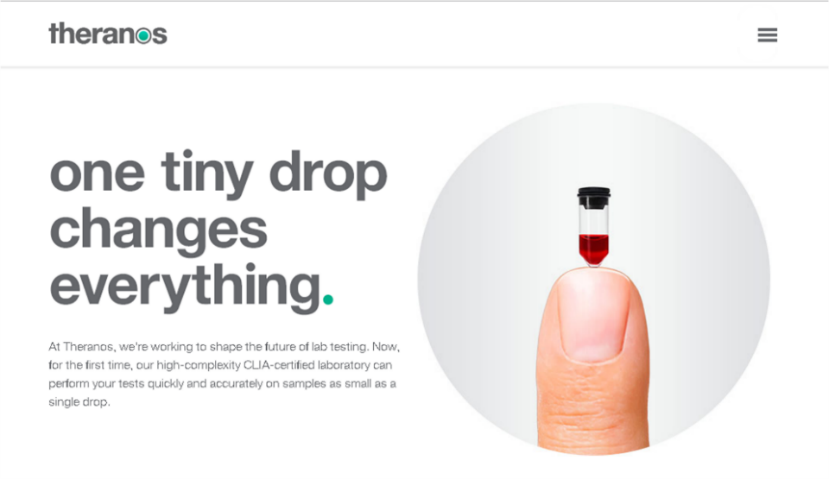Fake News and Competitive Strategy
Posted by |

The diagnostic industry provides essential information for healthcare, and is driven by medical technology, the aging population, and the complexity of disease. One sector, the global blood testing market, in 2015 was valued at $51.5 billion and is expected to grow to $62.9 billion by 2024. Understanding how to craft strategy in this market is critical, given the funding required for new ventures, and it is nuanced, given the often unusual business practices that can be employed by one’s competitors.
Theranos was founded by then 19-year-old Elizabeth Holmes, a Stanford dropout aspiring to change medicine. Theranos’s strategy regarding finger prick diagnostics was to provide cheap, quick tests of chemical levels in patients’ blood to determine dosing and effects of drugs in development. This technology was touted to measure up to 70 different markers in a single a drop of blood.
Success was nearly immediate. By 2014, the company was valued at $9 billion and had lucrative or encouraging deals with Blue Cross Blue Shield, Walgreens, Safeway, and the Cleveland Clinic.
Success Questioned
However, it wasn’t until Pulitzer Prize-winning Wall Street Journal reporter John Carreyrou started digging that the truth about the fing

er prick technology was revealed: the company’s blood testing device, called Edison, couldn’t accurately detect enough molecules in blood samples to provide accurate readings. To compensate, Theranos would dilute samples taken via the finger stick and run them through blood testing devices manufactured by Siemens, the equipment used by virtually every other blood testing company.
Bad news kept following. Theranos had reported receiving income from deals with Pfizer and GSK, which had reportedly used the Edison technology in clinical trials. GSK and Pfizer took pains to correct the reporting:
- “I cannot find any evidence that we’ve done business with them in recent years,” a spokesperson for GSK told the Times.
- Mary Anne Rhyne, a spokeswoman for GSK told The Verge, “GSK has not done any business with Theranos in the past two years.”
- Pfizer told the Financial Times: “We’ve done only very limited historical exploratory work with Theranos through a few pilot projects and we do not have any current or active projects with them.”
Peer reviews, a standard in the medical industry, were noteworthy in their absence. Theranos never published peer-reviewed studies comparing its tests to traditional ones and the company did not allow independent experts to publicly assess its labs, citing the need to protect its intellectual property.
Dr. Jerry Yao, a professor and director of Clinical Chemistry Laboratories from the University of Chicago said, “They completely bypassed the traditional process of peer review or publishing in peer-reviewed journals or having peer labs evaluate their product.”
The Art of Competitive Strategy
Competitive strategy practitioners aren’t the only ones who know to look for these signs of troubled medical and business methods. Investors were skittish about Theranos’ platform as well, including Google Ventures or “GV.” How did they know what was wrong? GV noticed that Theranos board members consisted of political and military officials versus medical experts, unusual for a medical diagnostic company. Furthermore, GV sent an employee to get the test done at Walgreens and found that Theranos needed more than a drop of blood in its nanotainers and required more than one patient visit. GV passed on the investment: “We looked at it a couple times, but there was so much hand-waving — like, Look over here! — that we couldn’t figure it out.”
In March 2015, Cleveland Clinic announced a strategic alliance with Theranos, not as an investment but as a test of the blood diagnostic tool. The clinic’s CEO, Dr. Toby Cosgrove, told CNBC: “Everybody is skeptical about something that is disruptive in a new industry, and I think that’s perfectly reasonable that they should be…I think that we need to have that verification done externally by a third party and we’d like to do that.”
Yet despite the clinic’s willingness to test the machine, it has not been given an opportunity to do so. In June of 2016, Dr. Cosgrove told CNBC that he was still waiting to perform the testing: “I’m disappointed. I hoped that this [testing] would happen in the near future. The promise of that technology is huge. Whether it works or not we have to see. We don’t have a financial investment. I don’t have a personal investment. But we have offered to test her machine anytime that she’s willing to do that. We haven’t progressed to that so far.” Cosgrove told CNBC’s “Squawk Box.”
Since Theranos does not have peer-reviewed studies, it’s important to examine published studies conducted by other institutions. In March 2016, the Journal of Clinical Investigation published a study comparing Theranos to Quest and LapCorp. The study cohort consisted of 60 healthy adults who were used to compare the uncertainty and accuracy in 22 common clinical lab tests between Theranos, which offered blood tests obtained from finger prick, and Quest and LabCorp, which required standard venipuncture draws. The result of these studies: Theranos collection had higher sample rejection rates, measures were 1.6 times outside their normal range, and reported systemic bias.
Despite these studies Walgreens invested in Theranos, eager to use the technology in its drugstores. According to current and former Walgreens employees, officials at the company had their doubts and even considered walking away from the deal, but worried Theranos would sue for breach of contract, and partner with another drugstore chain. In October 2012, executives from Walgreens visited Theranos and an executive described the meeting: “It was a very strange situation. The results were actually really good, but I was never allowed to go into the lab. I have no idea that the results I saw were run on the Edison devices or not.” Walgreens executives were chaperoned, including trips to the bathroom. Walgreens is currently suing Theranos for $140 million.
Lessons Learned
So what is the overall outcome and what lessons can be learned by participants in the medical diagnostics sector? Aside from Holmes fighting the ban placed on her from operating labs, Theranos recently announced that it will close its clinical labs and blood-test centers and has already reduced more than 40% of its staff. Theranos introduced a “new” platform called the minilab, which is capable of carrying out an array of tests on blood drawn from a finger prick. This strategy was introduced for the first time at a medical conference, something that Theranos never did with Edison. Holmes and her team have moved from the game-changing diagnostic innovation proclaimed at the start of the business to a mundane diagnostic facility. “Every piece of technology they presented has been known for many years, and exists in other platforms largely in the same configuration, or in some cases in much more compact form in competitor’s platforms,” said Geoffrey Baird, an associate professor of laboratory medicine at the University of Washington.
Companies and investors, especially those operating in a highly dynamic and competitive sector such medical diagnostics, need the rigor of competitive strategy to analyze situations such as those presented by Theranos. A new player, claiming innovative techniques and impressive albeit shadowy results, can be music to the ears of executive and investor alike. Yet it is only by analyzing the myriad of data – the third party studies, the limited access to facilities and personnel, the unsubstantiated medical results, and the failed partnerships – that we gain the insight necessary to create strategies that address the opportunity in a manner that mitigates the risk. Had investors – including Walgreens and Cleveland Clinic – taken pause to fully investigate and analyze the circumstances behind the marketing, they would have been better prepared engage Theranos on more appropriate terms.
How does your competitive strategy measure up to other companies?
Tags: BioPharma, Competitive Strategy, Diagnostics, Healthcare & Life Sciences



















